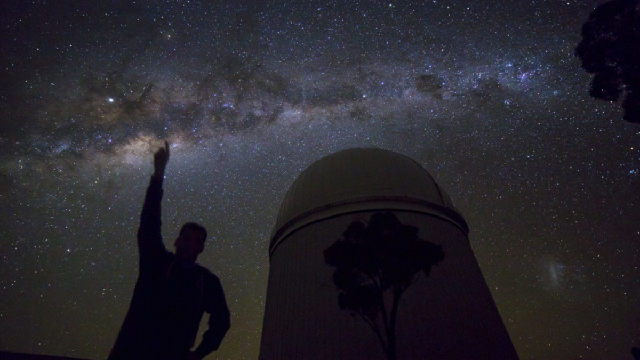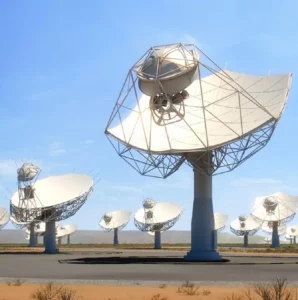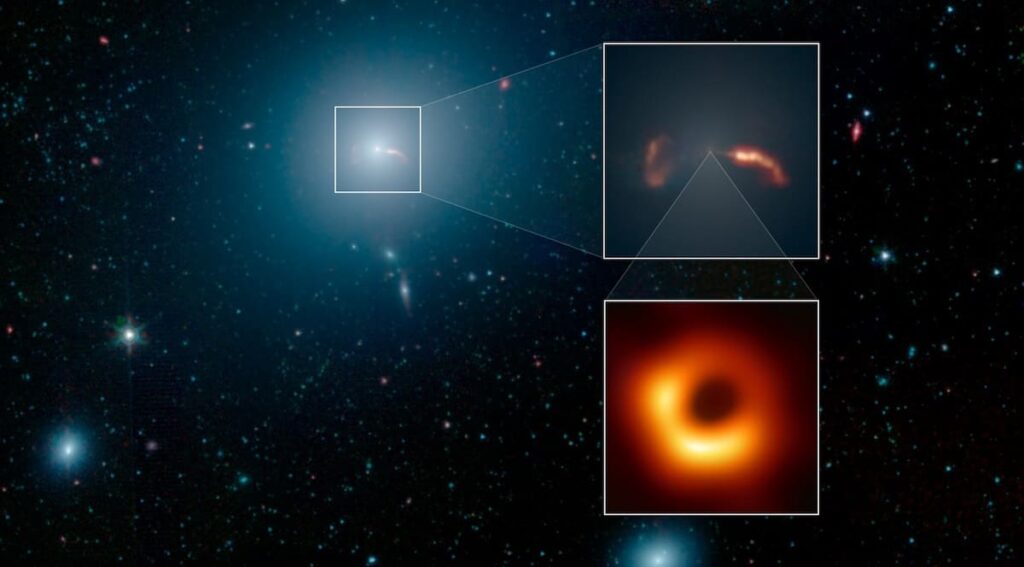Thoughts on what technology does to astronomy.
For students who want to find out about what’s going on in astronomy right now, what questions are being asked and which are being answered. This article could be used to inspire year 9 and 10 students with an interest in Technology, Space and Physics.
Word Count: 1349

As Cosmos reported this week, new technology continues to change the already hi-tech world of space watching, with the likes of AI, deep learning and computational modelling complementing and expanding on the data that comes from telescopes and satellites.
![]()
We spoke with Alan Duffy, an astrophysicist at Australia’s Swinburne University of Technology, about what we know and what we want to know.
Space watching is changing. What, to you, are the most significant changes?
If astronomy in the 20th century was about opening up the full wavelength range of light to explore the heavens, the 21st century is about exploring the full spectrum of the sky as it changes in time. From the motion of stars over the course of years, our Moon or the planets wandering from our point of view over days, to events on our Sun or Jupiter’s atmosphere in minutes.
The sky looks very different if you look across different timespans. But now we can look even more quickly, revealing gigantic explosions occurring faster than the blink of the eye, and we have no idea what is causing that; who knows what remains to be found out there as we continue to explore evermore.
Does technology change the way astronomers and astrophysicists work and think?
I like to hope that it doesn’t change the way we think, that we are still following the same thoughtful and curiosity difference research style that we always have just at larger scales and with better equipment.
There’s no doubt that the technology is changing how we work, however. Our telescopes produce so many images, so much data, that often no human looks at any of it except for the tiny subset which our AI alerts us too. That’s a different way of operating and I sometimes get uncomfortable that we might be missing the surprises out there: that current AI techniques are not flexible enough to spot things, unlike humans who are fantastic at rapidly detecting something new and interesting.
What can we not yet do that you’d like to?

We actually can do, or soon will be able to do, almost everything I hope for. Typically, AI isn’t able to explain to humans why a certain source was selected over another: the reason for its decision if you will. New tools are helping us to even rectify that.
Probably the one thing we can’t do, and likely never will be able too, is store all the data from new mega-telescopes like the Square Kilometre Array. Essentially, it’s creating an internet’s worth of data every few days and there’s not enough hard discs to save it all. So we will use AI to sift through it as best we can and hope that we didn’t miss anything there before deleting it for good.
Will we ever know it all? What are the “known unknowns”?
Every time in history a scientist has said we are on the verge of wrapping up a field they have been embarrassed by a huge new discovery just a year or two later. That’s not the same as saying that it’s possible to know it all… eventually! And I think we have a reasonable chance of seeing enough galaxies, types of stars and other astrophysical objects to have the story of the large well understood.
Once you get to planets, the complexity becomes much greater. And throw in life and all bets are off. Paradoxically I suspect we will know all about the biggest parts of our cosmos than the smallest. In terms of known unknowns, well that’s the nature of dark energy, dark matter and, of course, the Big Bang itself. There’s no reason to suspect we will ever know what the start of time and space itself actually was. But I hope we will.
What have been the most significant recent discoveries?
Easily the most significant has been the detection of gravitational waves, opening up an entirely new way of exploring the Universe, by “hearing” the collision of black holes that then causes these ripples in spacetime. The ARC Centre of Excellence for Gravitational Wave Discovery (OzGrav), headquartered at Swinburne, is investigating further uses of the ripples to probe the very nature of the Universe itself.
Another huge discovery, but one that was tinged with sadness, was the weighing of the atoms in the vast reaches between galaxies. About a fifth of all the atoms lay there completely invisible until illuminated by impossibly powerful radio waves from exploding, well, somethings. We’re not sure what causes these Fast Radio Bursts, but the weighing of these atoms is now known as the Macquart Relation after the first author on the paper that revealed this, who suddenly and tragically died just weeks later. Who knows what more significant discoveries JP Macquart would have made in the coming years.
To the public, huge black holes and exploding stars get the pulse raising. What excites the professional?
Absolutely the same thing. But we also love the tiny details: the change of a signal from that exploding star that reveals the material it passes through (the Macquart Relation) or just seeing something completely new, for the very first time.

For me, there is simply no greater example of that the image of the supermassive black hole in the centre of the M87 galaxy. Taken by the Event Horizon Telescope, really a world-spanning collection of observatories all combined via supercomputers, this image is a shadow surrounded by a glowing circle of material. The darkness in the centre is the impossible photograph – a black hole, where all light has been pulled into that darkness and indeed causing the end of space and time itself in the singularity at its core.
What’s the next big thing?
I’m biased, but I think it will be the discovery of the nature of dark matter. It’s a close race, however, with the discovery of the first Earth-like world around a Sun-like star, a twin of our own planet. Thanks to new telescopes like the James Webb Space Telescope, TESS and even backyard astronomers, it’s just a matter of time before we find that Earth 2.0 and then the fun will really begin to determine if it has surface water, oxygen/methane mix in its air and other key indicators for life as we know it. Much as I love dark matter, I have to admit, finding alien life would be officially the biggest thing imaginable.
Is the sky changing?
Every second of every minute of every day – but you have to look in the right way to see it. Or just be very lucky. From shooting stars to new satellite trains launched by SpaceX, there’s never been more going on overhead.
You can also be a part of new facilities like the Large Scale Synoptic Telescopes, now christened the Vera C Rubin Observatory after the great American astronomer. This new facility will take images of the entire night sky, in exquisite detail and sensitivity, every few days. It will show just how much the sky changes, and I think Vera would be proud to have her name attached to such a stunningly advanced and ambitious facility.
For National Science Week this year, you’re hosting a virtual tour of space. How on earth did you plan the itinerary?
Thanks to an Inspiring Australia grant, we were able to send thousands of VR headsets across Australia to allow people to explore the virtual Universe with OzGrav’s Science in VR app on their smartphones. Even if you didn’t get a free headset (and the lottery for that has now closed, sorry all!) you can head to www.scivr.com.au for details on how to use the app in non-VR mode on your smartphone.
Together with my Swinburne colleague and co-host Rebecca Allen we wanted to showcase the changing sky. SciVR now automatically downloads the very latest detections, meaning each time you open the app you will see a completely new set of exploding stars or colliding black holes. It makes it hard to plan for a talk when you don’t quite know what will have happened in the sky that week.
This article is originally published by Cosmos as Cosmos Q&A: Eye and AI on the sky.
Login or Sign up for FREE to download a copy of the full teacher resource





